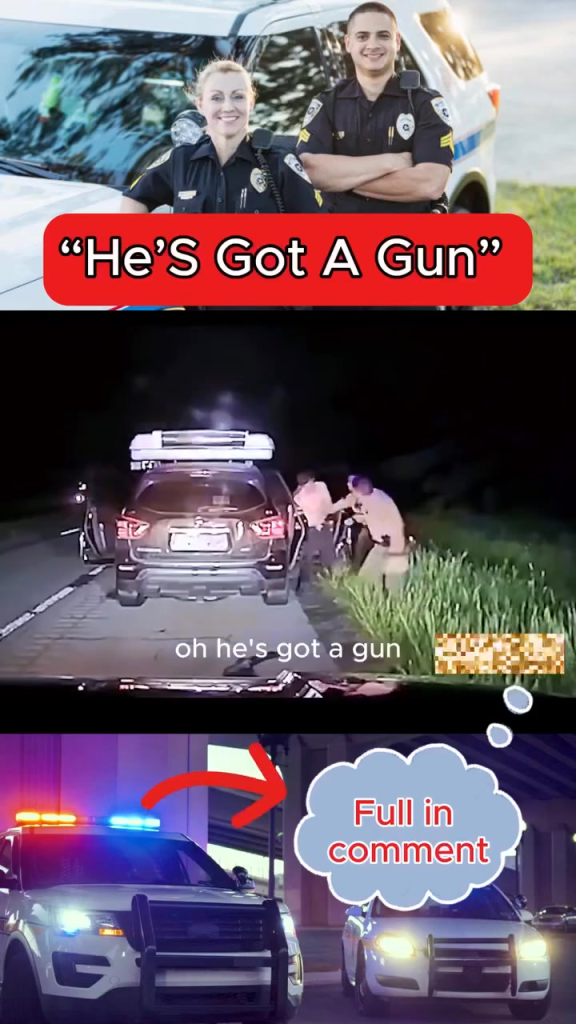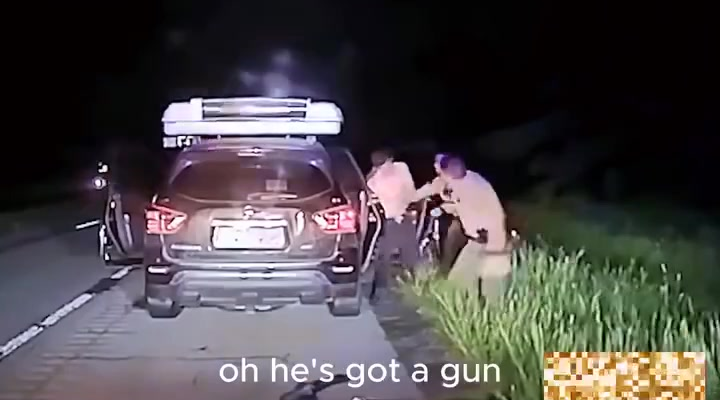Traffic stops are among the most common points of contact between citizens and law enforcement. For many drivers, these moments end with a simple warning or a citation. Yet, in certain situations, what begins as a routine interaction can unexpectedly escalate, leaving lasting effects on individuals and communities alike.
This dynamic was highlighted on a quiet Illinois highway when a traffic stop spiraled into confrontation. What initially appeared to be a standard encounter — a trooper addressing a minor infraction — turned into a tense situation that ultimately left one officer injured and a community grappling with questions about safety, accountability, and trust.
The event, documented through both dashcam and bodycam footage, serves as a powerful reminder of the unpredictable nature of policing and the importance of cooperation during such encounters. Beyond the incident itself, it has reignited national discussions surrounding law enforcement practices, public behavior during stops, and the fragile balance that exists between authority and civil rights.
This expanded analysis will explore the Illinois traffic stop comprehensively — retracing the timeline of events, assessing law enforcement conduct, examining the driver’s behavior, reviewing the community response, analyzing the legal aftermath, and reflecting on what broader lessons society can draw from such incidents.
The Road to Confrontation
The Context of Traffic Stops in Illinois
Illinois, like many other states, has a well-established set of traffic safety regulations designed to protect drivers, passengers, and pedestrians. Among these laws is the mandatory use of seatbelts, a requirement that has been proven to reduce injuries and fatalities. Violations typically result in small fines or warnings, rarely leading to serious outcomes.
Yet, history has shown that traffic stops are unpredictable. While most conclude without incident, officers are trained to approach vehicles with caution. From their perspective, there is always a degree of uncertainty: they do not know the driver’s mental state, whether weapons are present, or if other factors may complicate the situation.
It was under such circumstances that an Illinois State Trooper noticed a vehicle pulled to the roadside. Observing that the driver appeared not to be wearing a seatbelt, the trooper initiated a stop — a lawful and routine response to what seemed like a minor infraction.
Initial Engagement
Dashcam footage captures the trooper approaching with professionalism and composure. His communication style was measured, combining firmness with patience. He attempted to de-escalate by clarifying expectations:
“There’s no reason to lie to us when we’re just trying to help. You guys could have been long down the road, probably 15, 20 minutes ago… if you would have just said, ‘Here’s my ID.’”
At this point, nothing about the encounter suggested that it would escalate. The trooper’s tone reflected a desire to resolve the situation swiftly, issue the necessary citation, and allow the driver to continue on his way.
However, the driver, later identified as Brandon, resisted cooperation. Instead of providing identification, he questioned the trooper’s authority and declined to comply with lawful requests. While citizens have rights during traffic stops, including the right to remain silent and to contest citations in court, outright refusal to provide identification during a lawful stop often complicates the situation significantly.
Escalation and Tension
A Turning Point
What could have been a simple matter of handing over an ID and possibly receiving a ticket transformed into a standoff. Brandon’s repeated refusal to comply shifted the tone from calm engagement to confrontation. For the officer, this created uncertainty and concern for safety — key factors that can escalate stress during traffic stops.
The refusal to cooperate may have stemmed from personal mistrust of law enforcement, misunderstanding of legal obligations, or a deliberate act of defiance. Regardless of motive, the refusal set into motion a series of events that heightened tensions and increased risk for both parties.
The Moment Violence Erupted
According to reports and footage, the interaction took a violent turn. The exact sequence remains under legal and investigative scrutiny, but what is clear is that the trooper sustained injuries during the altercation. Emergency response teams arrived shortly afterward, providing medical assistance and securing the scene.
It was no longer a matter of a seatbelt citation. The encounter had escalated into a serious law enforcement emergency with lasting consequences.
Community Reaction
Shock and Concern
When incidents like this occur, they rarely remain isolated events. Word spread quickly across Illinois communities and beyond, largely due to the release of dashcam and bodycam footage. Many residents expressed shock that something so routine could unravel so dramatically.
Community leaders emphasized the importance of cooperation during traffic stops. Religious figures, educators, and local officials spoke about the need for calm, reminding citizens that disagreements about citations should be handled through legal processes, not confrontations on the roadside.
Conversations About Policing
At the same time, the incident reignited conversations about police training, use of force, and accountability. Some community members questioned whether different de-escalation strategies could have prevented the outcome, while others pointed to the driver’s resistance as the key factor that placed both the officer and himself at risk.
Social media amplified these conversations, with debates spanning from civil rights to law enforcement procedures. Hashtags related to Illinois policing trended regionally, demonstrating the broad public interest in how such events unfold and are handled.
Legal Aftermath
Charges and Proceedings
Following the incident, legal proceedings were initiated. Brandon faced charges stemming from his refusal to comply, as well as charges related to the physical confrontation. Prosecutors emphasized that the case was not simply about a seatbelt violation but about obstruction and violence during a lawful stop.
Court documents revealed a range of possible penalties, from fines and probation to imprisonment, depending on how the court evaluated the severity of the officer’s injuries and the level of resistance involved.
The Trooper’s Recovery
The Illinois State Trooper who was injured received medical treatment and was later reported to be recovering. Support poured in from colleagues, fellow officers, and members of the public. Law enforcement organizations used the moment to highlight the risks officers face daily, even during seemingly minor interactions.
Broader Lessons
Importance of Cooperation
This incident underscores the importance of cooperation during traffic stops. While individuals may feel frustrated or believe they have been unfairly targeted, refusing to comply on the roadside often exacerbates the situation. Courts exist to adjudicate disputes, and resisting officers in the moment only increases risks for everyone involved.
The Role of De-Escalation
At the same time, law enforcement agencies continue to examine how de-escalation strategies can reduce tensions. Training officers to maintain calm, clear communication — as the Illinois trooper initially demonstrated — is crucial. However, even the best training cannot eliminate risk when individuals refuse lawful orders.
Building Community Trust
Another key lesson is the importance of trust between law enforcement and the communities they serve. When trust erodes, interactions become more volatile. Building trust requires transparency, accountability, and consistent outreach from both sides. The release of bodycam and dashcam footage after this incident helped provide clarity, but true trust-building is a long-term process.
National Implications
Traffic Stops as a Flashpoint
Across the United States, traffic stops remain one of the most frequent points of contact between citizens and police. Studies show that these encounters, while routine in many cases, are also among the most likely to generate conflict. As such, they have become flashpoints in national discussions about policing.
Calls for Reform
Advocates for reform point to incidents like this one as evidence of the need for continued investment in officer training, mental health support, and public education about citizens’ rights and responsibilities during stops. Legal experts also suggest that clearer communication from states regarding traffic stop procedures could reduce confusion and resistance.
Balancing Rights and Safety
Ultimately, the challenge lies in balancing civil liberties with public safety. Citizens have the right to question authority, but they also have legal obligations during traffic stops. Similarly, officers must enforce the law while striving to respect individual rights and maintain professionalism. Finding the right balance remains a central challenge for modern law enforcement.
Moving Forward
Lessons for Citizens
For drivers, the takeaway is clear: even if one disagrees with the reason for a stop, compliance in the moment is the safest path forward. Legal systems exist to contest citations or perceived misconduct. Escalating tensions on the roadside can have consequences that far outweigh the inconvenience of a ticket.

Lessons for Law Enforcement
For officers, the Illinois case reinforces the importance of patience, vigilance, and preparedness. While the trooper involved demonstrated professionalism, the unpredictable turn of events shows why law enforcement training must constantly evolve to address both compliance and resistance.
Lessons for Communities
Communities must also reflect on their role. Supporting both accountability in policing and responsibility among citizens creates an environment where traffic stops and other encounters can proceed with minimal risk. Dialogue between community leaders and law enforcement agencies can bridge divides and prevent mistrust from undermining public safety.
Conclusion
The Illinois traffic stop that escalated into violence stands as a sobering reminder of how quickly routine interactions can change lives. What began as a minor seatbelt infraction ended with injuries, legal consequences, and widespread community debate.
The incident highlights the unpredictable nature of law enforcement, the necessity of cooperation during stops, and the ongoing challenge of maintaining trust between police and the public. It also underscores the need for continued dialogue about reform, accountability, and shared responsibility.
While the immediate aftermath brought pain and controversy, the long-term lessons have the potential to foster safer, more respectful interactions across the nation. If citizens, law enforcement, and communities alike commit to learning from moments like these, future encounters on the road may be less likely to spiral into chaos — and more likely to reflect the mutual respect and cooperation that underpin a healthy society.



